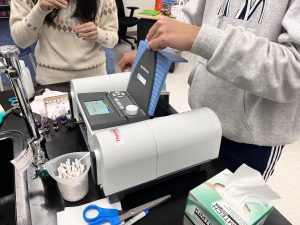Algae Beads. Light rays. Statistical significance. These seemingly unrelated topics come together in the final project for Research Statistics 1 (RS1), integrating all three.
After over a decade of RS1 being a core semester class for freshmen, it is finally being integrated into Jefferson’s Integrated Biology Engineering Statistics and Technology (IBEST) program in the form of a final project.
The Evolution of IBEST
For more than a decade, Integrated Biology, English, and Technology (IBET) was a program that all freshmen at Jefferson went through with a single “rotation” class, meant to assist incoming freshmen in familiarizing themselves with a smaller group of people. Rotation classes move together to English 9 Honors, Design and Technology, and Biology Honors classes as a group. After more than ten years in the Jefferson curriculum, RS1 was integrated into IBET last year. This year, the 2023-2024 school year, was the first time a project integrated both statistics and biology knowledge.
“I think for a long time, since we’ve had Research Statistics, which is over a decade now, we’ve talked about how it could be integrated. When we started the course, the purpose was to support any research happening here at [Jefferson], so that’s why it’s called ‘Research Statistics,'” statistics teacher Marianne Razzino said.

RS1 being integrated into what is now known as IBEST had influences on the classes outside of the project. Biology, for example, had its curriculum sequence restructured to put the topics needed in the project at the beginning of the year. For Biology, this ended up being a change for the better. Units were moved around in a way that made more sense to students and encouraged class discussion.
“We changed the sequence of our course so that photosynthesis and cellular respiration would be taught before winter break. The cool thing is that change moved cells and cell organelles right next to cell division, which is where our ninth-grade students associate [them] anyway,” biology teacher Aubrie Holman said. “I’ve had great questions from students which deepens their knowledge and deepens my knowledge. We’ve had great conversations as a team of teachers as we’ve worked to put this lab out to everybody.”
The project also prepared freshmen for future science courses by allowing them to familiarize themselves with advanced equipment.
“We’re building not just horizontal connections within a school year, but from grade level to grade level, which in teacher speak, we call ‘vertical articulation,’” Holman said.
The Project
The final project to end the semester most notably integrates RS1 and biology, with elements of Design and Technology included in the project. During the biology portion of the project, students studied cultured algae beads under different light conditions. Students then measured the absorbance and pH of the water surrounding the algae beads after 48 hours of photosynthesis under different light filters and conditions. After recording their results, students uploaded their data to a spreadsheet to be used by all freshmen to use in their projects. The independent variable in the experiment—the light filter color—was individually picked by each group.
“[Our group is] comparing the differences between the algae beads underneath red light [against] green light,” freshman Roshen Virupannavar said. “Red light is the best light for [absorbance] and green light is the worst, so we [picked those] to get a clear difference.”
On the other hand, another popular light to test was white light because it contains every other color in the spectrum.
“So I picked different colors of lights [to compare]. I picked purple and white [colored lights], I saw that there was a graph with all of the light colors, and purple was one of the most efficient, so I wanted to compare it to white light,” freshman Tan Ho said.
The statistics portion of the project was split into three parts: experimental design, data and description, and inference and conclusions. Groups of either one or two picked which variables they wanted to test and collected data from the experiments on it. In part two, students described the data and wrote SOCS (shape, outliers, center, spread) paragraphs on their findings. In the final section, students reflected on the feedback from their teachers on the first two parts and wrote conclusions against their hypotheses. Overall, the project was well received by students, but there was still some criticism to be made.
“The hardest part of the project was the [tedious] work, like copying and pasting data over and over again,” Ho said.
Students had one final piece of advice they wanted to share for future freshmen taking the project.
“Work with a partner,” Ho said. “You’ll get more inputs and overall, it [makes it] easier.”

